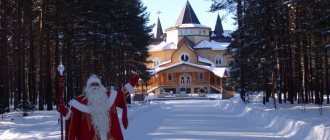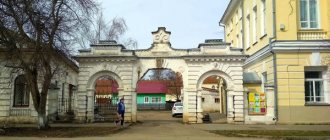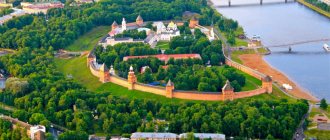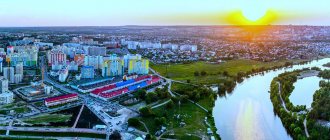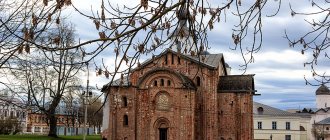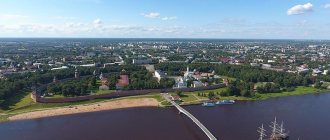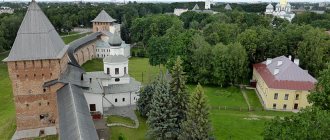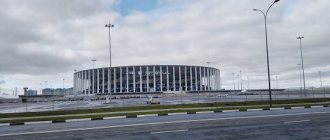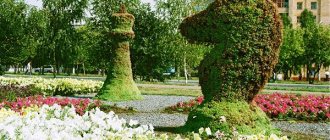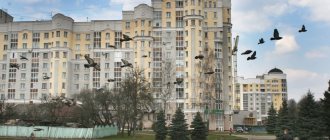| Sights with children What to see for adults What to see in the surrounding area Reviews of tourists Where to stay in Veliky Ustyug |
For more than twenty years, Veliky Ustyug has been known as the birthplace of the Russian Father Frost. It is in winter that this fact attracts thousands of families with children to the city, coming on their own or by special buses and trains. But, besides this, it will be interesting for those who love museums and walks among ancient walls: Veliky Ustyug is a stunning example of Old Russian temple and merchant architecture, a city with rich craft traditions.
When going to Veliky Ustyug in winter, you should seriously insulate yourself. It is not for nothing that the city belongs to the territory of the Russian North, the average temperature in December-February is -9...-16 °C, frosts of -20...-30 °C and even more are not uncommon. There is usually always enough snow, and decent snowdrifts accumulate by the end of winter.
Conveniently, visiting attractions outdoors and indoors can be alternated. This applies to the Estate of Father Frost and other city objects. Most of the latter are included in the Veliky Ustyug Historical, Architectural and Art Museum-Reserve: in the most beautiful churches and venerable mansions there are not only temples, but also museums. What exactly can adult tourists see in Veliky Ustyug in winter or what can parents and children do - later in this advice.
Photo: © Sergey Vasilets
Attractions with children
Since 1999, Veliky Ustyug has been considered the home of Father Frost, which is why thousands of children are brought here, reinforcing their belief in the New Year’s miracle. Many exciting excursions and interactive activities aimed at young tourists are held in the city's museums.
Residence of Father Frost
The place of attraction of winter Veliky Ustyug is the Estate of Father Frost. It is located in the middle of a pine forest in the outskirts of the city. Guests are greeted by fairy-tale characters whose huts are located on the “Trail of Fairy Tales” on the way to the wizard. Moroz himself occupies a carved two-story tower. In it you will see an office where all the miracles happen, a bedroom, a dressing room and a wizard’s library. At the end of the excursion there is a long-awaited meeting with Santa Claus in the Throne Hall of the tower.
Main Russian Frost Photo: © Marina2506
The farm of Father Frost is not limited to this and also includes: a post office, a glacier - a gallery of ice sculptures and an ice throne, a forge and a carpentry workshop, a zoo and a winter garden, a forest pharmacy. In each, educational and creative programs are organized for visitors. In addition, there is a cafe and restaurant, a hotel, souvenir shops on the territory, and for entertainment there are attractions and slides.
Read more: Santa Claus's house
Tower of Father Frost Photo: © Marina2506
At the City Residence of Father Frost at lane. Oktyabrsky, 1 guests will be told the history of the holiday, the wizard and his homeland. As representatives of Veliky Ustyug, the cultural center of the region, children will be occupied with creative master classes on creating a wicker belt, a painted birch bark souvenir or a “shark” rattle.
Nearby there is a small blue tower - Santa Claus's post office , where thousands of letters arrive from children from all over the world. The storyteller's assistants will tell you about the most unusual wishes, show you old postcards and offer to send news from the homeland of Santa Claus to friends and family.
Veliky Ustyug and at least 15 other places where Father Frost lives
Santa Claus Mail Photo: © Sergey Vasilets
Museum of New Year and Christmas toys
The theme of the holiday fairy tale in Veliky Ustyug will be continued by the Museum of New Year and Christmas Toys. A significant part of it is occupied by Russian Christmas tree decorations made of glass, wood, felt, birch bark, pumpkins, and cotton wool. Among them are original ones and those published in thousands of copies throughout the country.
With Christmas trees decorated according to decades, adults will be able to remember their childhood, and children will be able to get acquainted with school supplies and learning traditions in past years. This is the subject of the interactive lesson “Lessons in the Old Russian School”. A separate hall expands the geography and reveals the canons of New Year celebrations in other countries.
In the Museum of New Year's Toys Photo: © vladkonst
The museum occupies the Church of the Myrrh-Bearing Women . This is a common practice in the city, preserving architectural monuments where services are not currently held. The temple was erected in the first quarter of the 18th century. Its appearance has original details: scrolls above the window casings, a high porch and tiles in the design of the facades.
Read more: Museum of New Year and Christmas Toys
Children's Museum Center
The Children's Museum Center is an exhibition and leisure area for children and their parents. It occupies another architectural monument in the city center - the house of the Alenev icon painters, later sold to the merchant Chebaevsky. The building has a corner in the form of a covered rotunda with a balcony; one of the facades is decorated with antique columns and porticos.
Guests of winter Veliky Ustyug have access to exhibitions dedicated to the New Year and its attributes. Thus, the exhibition “Let the Christmas Tree Not Go Out” takes you back to the times of the pre-revolutionary and Soviet holiday, presenting the decor, fancy dress costumes, decorated Christmas trees, traditional and unusual Christmas tree decorations. The exhibition “Our Soviet Childhood. Toys from the 40s to the 80s. XX century." It surprises young people and immerses adult visitors in the best moments of childhood.
Usov House - Children's Museum Center Photo: © Sergey Vasilets
At the center's master classes, children independently decorate a New Year's toy in the style of Veliky Ustyug painting or create a souvenir from foil using the filigree technique. The most tireless are offered a game in which participants will learn about the significance and price of the achievements of the Ustyug explorers S. Dezhnev and E. Khabarov.
Read more: Chebaevsky's house
Sukhona embankment
Veliky Ustyug is located on the banks of the Sukhona at the confluence of the Yug River, which later gives birth to the Northern Dvina. To look at the wide, beautiful Sukhona hidden under the ice, go to the embankment. It starts from Krasnoarmeyskaya and stretches 3 km downstream of the Sukhona. The most interesting part for a walk is the part adjacent to the city center. There are activities for both children and adults here.
Veliky Ustyug embankment Photo: © Marina2506
While parents are looking at the line of city blocks with the domes of churches, children can swim in the snow to their hearts' content or ride down the slides going down to the river. It’s worth walking to Lenin Square : from November onwards there is a New Year’s tree , because on November 18th the birthday of Father Frost is celebrated. Closer to the river there is a sundial dedicated to the residents - famous travelers of past years.
“Aquarius” Photo: © Sergey Vasilets
The embankment runs past the Church of St. Nicholas , now the Museum of Ethnography , past the Cathedral Courtyard - a temple complex, the heart of ancient Ustyug. It also houses the Museum of History and Culture of the City and the Museum of Nature . In front of them on a bench sits E. P. Shilnikovsky - a monument to the artist and head of the Ustyug silver factory "Northern Chern". Another street sculpture is “Aquarius” , the coat of arms symbol of the city, personifying the unity of Sukhona and the South.
At the bottom of the embankment stands the stone church of Simeon the Stylite . It was built in 1765 and is distinguished by its rich architecture. Round windows, unusual frames, pilasters and a high main staircase refer the architecture of the temple and bell tower to Western European Baroque. The temple is open to visitors and services are held.
Church of Simeon the Stylite Photo: © vladkonst
Museum of Nature
The Regional Nature Museum is located on the city embankment and occupies an outbuilding of the house of the merchant Usov. Panoramic landscapes and animal figures show the local living world. They are complemented by the rustling of the inhabitants, the murmur of water and other sounds of the forest, thanks to which the stories become complete. In another part of the museum, an interactive exhibition has been organized, revealing the Vologda nature through the works of Russian painters.
The paleontological hall is also interactive. He talks about the times when dinosaurs and mammoths walked across the Vologda land. It will be interesting for children to take part in excavations and build a model of a whole lizard. A separate area is dedicated to the modern owner of forests - the bear. Here is everything about its structure, habits and nutrition. Guests will also be able to visit an impromptu den, light up the constellations Ursa Major and Ursa Minor, and remember the bears - the heroes of fairy tales.
Read more: Regional Nature Museum
We will list other museums in Veliky Ustyug below, since the main theme is more understandable for adults. However, many of them organize special children's excursions and events designed to tell about the cultural heritage of the city in an interesting and accessible way.
On pre- and post-New Year's dates, the Church of the Epiphany puts on a performance for children over 6 years old telling about the biblical events of Christmas night, the traditions of celebrating Christmas, and the meaning of the Christmas tree. There is also an interactive program dedicated to Christmas at the Museum of Ethnography. Family master classes on processing flax and creating a woven belt are also held there; in the Depository they introduce birch bark carving and the rituals of Russian tea drinking. The City History Museum gives you the opportunity to try bobbin lace weaving and organizes games in an old shop.
Folklore program Photo: © Irina Porunova
What other entertainment events are there in Veliky Ustyug?
Not far from the city, in a boarding house in the village of Bobrovnikovo, you can have a great time with your children, enjoying magical and spectacular performances with special effects, lights and music, and play various games with fairy-tale characters in theatrical programs.
On the territory of the sanatorium, adults and children can watch the New Year's play "Baron Munchausen in the Bobrovnikovsky Forest", a bright game program with dances and songs "Bereginya invites you to the New Year's bonfire", a theatrical performance "Russian hut invites you to visit" with a tasting of dishes cooked in a Russian oven with tea and pancakes.
Winter fun and outdoor games
You can truly feel winter with dazzling white snowdrifts, fresh winter air, and a fabulous forest reaching to the skies only in the village or outside the city. Most children's winter activities are located outside. It's time to dress warmly (after all, in the land of Santa Claus the climate is harsh and cold), go down the 300-meter-high snowy mountain on a sled, cheesecake or skis.
Or you can go to explore the possessions of Santa Claus on a snowmobile or use a more traditional method of transportation - on reindeer or horses. In the residence of the winter wizard, surrounded by fairy-tale characters, there are many attractions: you can ride on transport that is completely unusual for our days, for example, Emelya’s miracle stove or a funny little train.
Horseback riding and master class “Without a horse and Mother Rus' is empty”
Active pastime in the fresh air perfectly strengthens and heals the child's body. And this is doubly useful if communication with animals occurs at the same time. Horseback riding, horseback riding in real sledges or firewood with fragrant hay - how much joy and delight a sleigh, drawn by a frisky horse, brings to flushed children on a sunny day.
You can go to the real village of Barsukovo for a fascinating excursion with practical lessons on feeding and caring for horses, and acquiring skills in Russian harnessing of horses into a carriage. It is very close to Veliky Ustyug.
New Year in Russia is the most beloved, most important family holiday of the year. We have the kindest Father Frost and the beautiful Snow Maiden. Therefore, a New Year’s miracle can happen to anyone who is really, really looking forward to it and dreams of its fulfillment all year. They say that those who visit Veliky Ustyug to visit Father Frost will have all their wishes come true.
You can participate in the excursion program around Veliky Ustyug on your own by booking excursions, or buy a ready-made tour from the Orbita tour operator. All details on the page https://orbitaart.ru/veliki-ustuk.html.
What to watch for adults
Adult tourists coming to Veliky Ustyug also often visit the Estate of Father Frost. However, in most cases, the impressive discovery for them is the city itself. In the center of Ustyug, entire streets lined with merchant houses and slender white churches have been preserved.
Cathedral courtyard
One of the dominant features of Veliky Ustyug and its main attractions is the Cathedral Courtyard. This is a temple ensemble that occupies part of the Sukhona embankment.
The main thing in it is the Ustyug Assumption Cathedral . Its history begins in 1290. In the middle of the 16th century. it was rebuilt in stone, receiving the features of the Assumption Cathedral of the Moscow Kremlin and becoming the first stone church in the Russian North. The interior is rich in carvings and stucco, but is currently undergoing restoration. Inspection is only available from outside.
Cathedral courtyard Photo: © Sergey Vasilets
The Cathedral of Procopius the Righteous is a couple of centuries younger. It is open to parishioners and those wishing to see the elaborate iconostasis of the early 18th century, decorated with carvings and gold. Two centuries younger than it is the Cathedral of St. John of Ustyug , a summer one, erected on the site of a small wooden church. Recently opened after restoration.
Next to them in Pionersky Park there is a monument to Semyon Dezhnev , an outstanding native of the Russian North, explorer and discoverer of the strait between Chukotka and Kamchatka.
Sights of Veliky Ustyug
Cathedral of Procopius of Ustyug Photo: © vladkonst
Church of the Epiphany – Exhibition Hall
The Epiphany (Vlasyevskaya) Church on the Cathedral Courtyard is a small temple of the late 17th century, which served the daily needs of the Cathedral of John of Ustyug. It is unpretentious in appearance, but more than others it has retained its original image.
Today it houses the Exhibition Hall of the City Museum-Reserve. Temporary exhibitions present the works of local and Russian artists - artists, embroiderers, puppeteers. There are both personal exhibitions and events dedicated to certain events. The exhibition “Creation of Soul and Hands” has become traditional, inspiring with the creative works of veterans of Veliky Ustyug and the Veliky Ustyug region in embroidery, lace, and model making.
Read more: Church of the Epiphany
Museum of History and Culture
Studying the Museum of History and Culture of the city will help you delve deeper into the architectural heritage of Veliky Ustyug. The museum occupies the historical estate of the merchant Usov on the embankment. This is a two-story mansion in the classicist style. It was built at the end of the 18th century. and even before the Revolution it was sold to the city government.
The permanent exhibitions highlight the history of the city, its main crafts - carving and painting on birch bark, silver blackening, as well as the fine arts of local painters. With archaeological finds, coins, jewelry - piece by piece, the first tells about the early centuries of the last millennium, about the peoples who lived here, their way of life and significance in the history of the Russian state. A separate part is dedicated to the merchant Ustyug, the craft center of the Russian North. The museum is holding a master class on weaving Vologda bobbin lace.
Read more: Museum of History and Culture of Veliky Ustyug
Museum of History and Culture of Veliky Ustyug Photo: © Sergey Vasilets
St. Nicholas Church – Museum of Ethnography
One of the temples on the banks of the Sukhona is the Nikolo-Gostinskaya Church with a bell tower. The temple was an initiative of visitors who traded in Veliky Ustyug, and was built at the turn of the 17th-18th centuries. The combination of summer and winter churches in one was an innovation for the city. Today the church is adjacent to the New Year tree and the figure of V.I. Lenin.
The architectural monument, like other valuable churches, belongs to the Veliky Ustyug Museum-Reserve. Within its walls it hosts exhibitions of the Museum of Ethnography. “Folk Art of the Ustyug Land” is a permanent exhibition that conveys the diversity of the culture of the region in the period of the 17th - early 20th centuries. She introduces the objects of the peasant hut and urban life of the Ustyuzhans - wooden, forged, pottery, and besides them - women's costume and home textiles. Each of them is decorated with original carvings, designs or embroidery depicting plants, birds, animals, people or geometric designs.
Read more: St. Nicholas Church
St. Nicholas Church Photo: © Sergey Vasilets
Church of the Ascension – Museum of Ancient Russian Art
The Ascension Church stands at the intersection of the central arteries of Veliky Ustyug - Sovetsky Avenue and Krasnaya Street. The lavishly decorated snow-white temple built in 1648 is hard to miss. It is decorated with three rows of kokoshniks, black faceted domes, openwork crosses and various three-dimensional elements. Inside you can find an ancient gilded iconostasis with icons by Stefan Sokolov.
The temple is also a branch of the historical and architectural reserve - the Museum of Ancient Russian Art. It continues to reveal the cultural splendor of Veliky Ustyug. In addition to the unique iconostasis, within the walls of the church there are genuine relics: handwritten and early printed books, wooden sculpture, blackened silver, embroidery, icons created by Ustyug residents in their own manner. Among them, for example, is the 1496 icon of “The Dormition of the Mother of God” from the Assumption Cathedral and “Our Lady Hodegetria of Smolensk” from the mid-16th century.
Read more: Museum of Ancient Russian Art
Church of the Ascension Photo: © Marina2506
Blackening is the application of a pattern to metal products, based on creating small depressions and filling them with contrasting metal. Such processing has existed in Rus' since ancient times, but the masters of Veliky Ustyug made it an art. Veliky Ustyug blackening on silver - elegant and richly plotted designs. In the 19th century there was a decline in its demand, but in 1933 its revival was initiated by a hereditary master in the form of the Northern Mob artel. Developing successfully, in 1960 it became a factory that is still operating today.
The factory's products include jewelry, cutlery, crosses, icons, trays and souvenirs. You can not only purchase them, but also get acquainted with the process in the factory’s showroom upon prior request. On display are products from different years and authors, including exhibition winners. Guests can see first-hand the painstaking handwork and then decorate the silver coin themselves.
More details:
Exhibits of the showroom Photo: © vladkonst
Komsomolsky Square
Komsomolsky Square is located between Krasnaya and Pavel Pokrovsky streets. It hides a couple of pearls of old Russian architecture. The Church of the Transfiguration of the Savior, built in 1669, is a snow-white, elegantly decorated five-domed church with a bell tower. The facades are decorated with colorful tiles with drawings of plants, birds, and animals. Very close by stands the Sretenskaya Church , rebuilt later. Until 1920-1930 Both were part of the Spaso-Preobrazhensky Monastery; today they are occupied by the city archives.
In front of them is a monument to Erofei Khabarov , a pioneer and explorer of Siberia. The bas-reliefs depict scenes of his wanderings. The monument really surprises guests, because Khabarovsk, a city at the other end of the country, is named after the hero. It’s just that Erofey Pavlovich comes from these places. His figure, standing under the stele with a double-headed eagle, harmoniously fit into the temple ensemble.
Transfiguration and Sretenskaya churches, monument to E. Khabarov Photo: © Irina Porunova
Michael the Archangel Monastery
Next to Komsomolsky Square is the St. Michael the Archangel Monastery. According to the chronicles, it has existed since the beginning of the 13th century, but all the buildings in stone were made in the 17th-18th centuries, which in no way detracts from the attention to it. First of all, passers-by are attracted by the figured Holy Gates with spiers. Afterwards there is the Vladimir Gate Church, decorated with voluminous decor. It is followed by the one-story small Church of Mid-Pentecost.
The main one here is the St. Michael the Archangel Cathedral , connected by a passage with the Church of the Presentation . The four-pillar cathedral with five chapters, two chapels, galleries and a bell tower became the first of its kind in Veliky Ustyug. It has preserved paintings and an iconostasis with features of Baroque and Classicism. There are no services there, and access inside is limited: possible in the summer and only with a guided tour from the museum-reserve. One of the ancient shrines of the cathedral, an icon from the period XIII-XIV centuries. “The Cathedral of the Archangel Michael” can be seen in the Russian Museum of St. Petersburg.
Read more: St. Michael the Archangel Monastery
St. Michael the Archangel Cathedral Photo: © Sergey Vasilets
Depository
The depository of the Veliky Ustyug Historical and Architectural Museum-Reserve is a repository of museum exhibits. It is located next to the Children's Museum Center. In the halls accessible to the visitor, samples of tiles, objects made of carved birch bark and porcelain, furniture, and spinning wheels are stored.
Temporary exhibitions bring to light part of the collections related to a single theme. For example, exhibitions showed the works of the Ustyug photographer G. K. Lokhtin, who lived at the turn of the 19th-20th centuries, and a collection of skillful partner gifts for the anniversary of the service of S. M. Pryanishnikov, a man who devoted half a century to the work of the Lal paper mill (second half of the 19th - early XX centuries).
Urban architecture
Despite the presence of modern signs, traffic lights and other details, a walk through Veliky Ustyug is a journey into the past of a once rich city. Take a closer look: some of the shops, offices, kindergartens and other establishments are located in merchant mansions. These are one- or two-story houses made of stone or wood. Among them there are both simple and more complex in shape and beauty.
Some of the most prominent representatives of antiquity:
Shilov's house on the street. Shilova, 8 - a tall, two-story house with a mezzanine and a figured pediment above it. The façade is decorated with decorative platbands and divided by cornices. Construction began, presumably, at the end of the 17th century. It belonged to the Ustyug explorer V.I. Shilov.
Shilov's house Photo: © vladkonst
Zakharov's house on the street. Shilova, 9/2 - merchant mansion of the late 18th century. on one floor with a mezzanine. Decorated more modestly than the first, but still consistent with the success of the owner.
Neledinykh's house on the street. Krasnaya, 76 - a strong merchant mansion of a later construction and in some ways repeating the features of Shilov's house.
House of the Zhigalovs on the street. Vodnikov, 38 - corner house from the street. Engels. The corner of the wooden two-story building is decorated with a tent, and the entire decor of the building’s facades is made of wood.
Sovetsky Prospekt Photo: © vladkonst
Churches in Dymkovo
Opposite the Cathedral Courtyard on the other bank of the Sukhona lies the Dymkovskaya Settlement, now part of the borders of Ustyug. The area is famous for two ancient churches - Sergievskaya and Dmitrievskaya. They were first mentioned at the end of the 14th century, but have existed in stone form since the 1700s. The best panorama of the Cathedral Courtyard opens from the shore nearby. In winter, you can walk to Dymkovo on ice or drive across a bridge.
The five-domed temple of Demetrius of Thessalonica was used in the summer. Its architecture is simple, but at the same time majestic and entertaining. The main part is occupied by a quadrangle connected to the refectory and the bell tower. There are a lot of decorations on the outside, among which the five-meter-tall Image of the Almighty Savior on the eastern façade stands out. The main value of the decoration is the gilded carved iconostasis of the 18th century, however, at present the temple is not in use and inspections are not carried out inside.
The single-domed Church of St. Sergius of Radonezh is extended due to extensions. The temple was open even in winter; tiled stoves were preserved in it.
Temple of Dmitry Solunsky Photo: © vladkonst
Glass Bottle Museum
Address: Sovetsky Prospekt, building 121 (opposite Lenin Square).
This small but unique museum for Russia appeared thanks to the efforts of Alexander Kokovin. Now there are 600 exhibits on display, most of which are dishes from the times of the Russian Empire.
Here are bottles into which alcoholic drinks were poured, as well as utensils used in perfume production and pharmaceuticals. There are also containers for milk and lemonade.
The sights of Veliky Ustyug are interesting for both children and adults and are of great historical and cultural value. They are objects of Russian cultural heritage.
What to see in the area
Veliky Ustyug is surrounded by meadows and dense forests, which are threaded by three large rivers. It is difficult to blame nature for anything; it is beautiful both in its snow-white robe and in the greenery of summer. Among the specific places where tourists visit, most often the forgotten monastery and the “Sukhonsky miracle” - an unusual-looking section of the Sukhona River.
Photo: © Sergey Vasilets
Trinity-Gledensky Monastery
On the other side of the Sukhona, on a hill near the confluence with the South, lies the village of Morozovitsa . People visit it to look at the ensemble of the Trinity-Gleden Monastery. The monastery was founded in the city of Gleden, now defunct. Unlike the city, it survived the civil strife of the Russian princes, and in the 17th-18th centuries. rebuilt in stone.
Now the Trinity Cathedral and the Tikhvin Church rise on the territory. Surprisingly, the institutions of the Soviet era did not violate their architectural integrity. The pearl of the cathedral is a carved, gilded iconostasis with icons reminiscent of European painting. You can explore the monastery from the outside on your own in winter or summer, but excursions inside are only available in the summer. The surrounding landscape of the monastery is always worthy of attention - the river expanses at the junction of large rivers.
Read more: Trinity-Gledensky Monastery
Opoki
One of the remarkable places in the vicinity of Ustyug that you can visit in winter is Opoki, which is 63 km from the city. This is both the rapids on the Sukhona and the steep, exposed right bank of the river near the village of Porog. The slope is composed of red and white rocks, alternating horizontal layers. A small stream washed it through, dividing it in two.
The rapids on the river are long, shallow, but fast flowing. In winter it is unlikely to be seen as the river freezes. The well is of greatest interest: the jet gushing out like a fountain creates high walls of ice. It is located on the other side of the river a kilometer below the Threshold. To get to the fountain, you need to cross to the other side. After snow, you may have to pave the trail yourself. You need to be careful on the ice; there are gullies in some places.
Read more: Opoki in the Vologda region
Ice fountain in Opoki Photo: © Kristina Kosinskaya
Reviews from tourists
In winter, some tourists come to Veliky Ustyug to visit Father Frost, while others come to get acquainted with the appearance of the city itself. Some manage to combine both options. Having noticed a lot of fascinating things, guests regret the lack of time for a detailed inspection. Therefore, it is worth setting aside more than a day to get acquainted with Ustyug for those who are interested in culture, arts, and beautiful architecture.
Users of the site told about their journey:
- Marina in the story “Give Children a Fairy Tale”;
- Sergey Vasilets in “The Great White Ustyug and the Big Black Locomotive”;
- Irina Porunova in “On the New Year Express to Visit Santa Claus.”
All tourist reviews about Veliky Ustyug on Tourister. RU
General information about the city is on its main page.
Photo: © Marina2506
City residence of Father Frost
Address: Sovetsky Prospekt, building 85.
The city itself houses the city residence of Father Frost. Here you can walk around the house, try on suits, take pictures, make an entry in the Book of Good Deeds, buy souvenirs, and attend a master class.
There is also a greeting card museum, which houses the world’s largest postcard “Veliky Ustyug. Troika of Santa Claus. Its dimensions: 4.2 x 2.8 meters.
Across the road is the Cathedral Courtyard.
